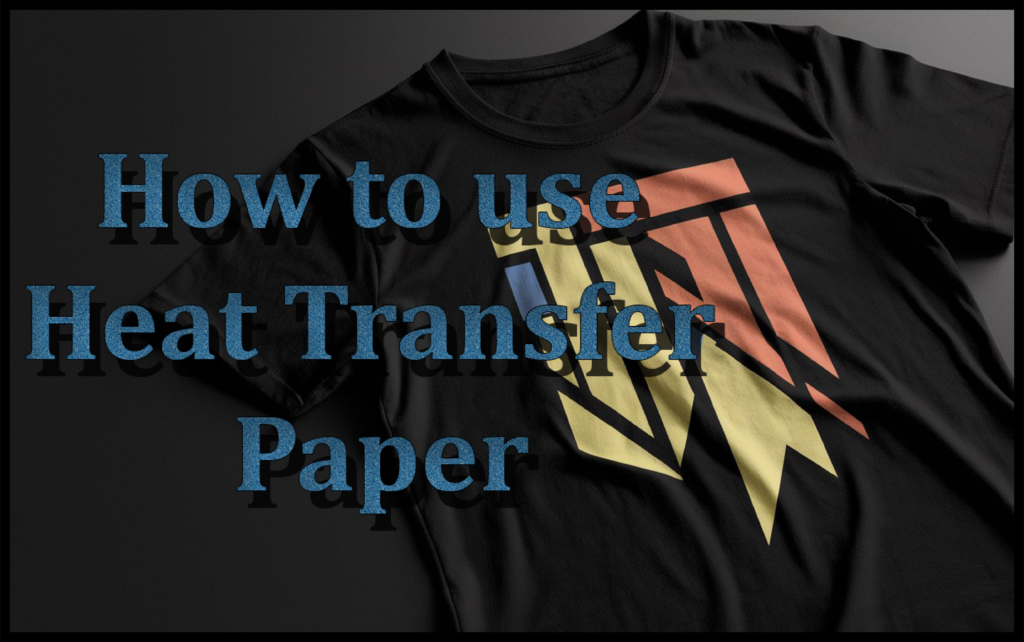How to use Heat Transfer Paper? If you are a crafter, you must have heard about that heat transfer paper (No matter if you have not, don’t worry in this article you will read it below).
Today we are gonna tell you the method of using Heat Transfer Paper but first you have to know about its types because every type has its different method of use.
What is Heat Transfer Paper?
Heat transfer paper is a special kind of paper that is used to transfer designs onto fabrics or other materials. There are two main types of it:
- Sublimation Transfer Paper
- Inkjet Heat Transfer Paper
What is Sublimation Transfer Paper?
Sublimation Transfer paper works with sublimation inks, in this type the design is dyed on the fabric with ink so the image does not crack or peel because the design is not on the surface. This type of paper is mostly used for light-colored fabrics.
What is Inkjet Heat Transfer Paper?
This type of paper works with regular inkjet inks and prints the design on the surface. Instead of dying the fabric, it has an extra coating on which the design sits. It is also known as the best transfer paper for shirts. Regular inkjet inks rely on the fabric’s color to show through because it is not opaque. It is further divided into two divisions.
- Heat transfer Paper Light
- Heat Transfer Paper Dark
What is Heat Transfer Paper Light?
It is a specific type of inkjet heat transfer paper designed for use with light-colored fabrics. Light transfer paper provides you white background with its special coating, it also provides vibrant colors because the ink sits on the white coating, without this white coating the colors would look muted or faint.
What is Heat Transfer Paper Dark?
It is a type of inkjet heat transfer paper, it is designed for dark-colored fabrics. It has a special coating in it that is slightly colored with some opacity and looks transparent that reduces the impacts on the design. This coating allows the ink to adhere better on dark-colored fabrics. It is more flexible compared to normal heat transfer paper.
So now you know the types and divisions of Heat Transfer Papers. Each type and division has its own method of use so you can pick one that is according to what you are needing. Here we go with the methods:
How to use Sublimation Transfer Paper?
Here is the method for using sublimation transfer paper. For this you will be needing a supplies;
Supplies:
- Sublimation Printer and Ink,
- Sublimation Transfer Paper,
- Heat Press,
- Heat Resistant Gloves (optional but recommended),
- Computer with Design Software,
- Fabric or any other material to print on,
- Scissor or Paper Cutter,
- Heat Resistant Tape (Optional)
Here is Step by Step Method,
Step I: Create a Design:
Create a design on your computer or get a premade design, remember to have a format that your machine supports. Remember to mirror your design because it gets flipped while printing.
Step II: Print It:
Insert your sublimation paper into your machine according to instructions given with your machine manufacturer. Remember to use the printable side for printing, usually the shining white side is the printable side of the paper. Using sublimation ink, print heat transfer paper with your design.
Step III: Transfer The Design:
Make sure that the fabric (or any other material that you are going to print on) is clean, dry and wrinkle free. Preheat your heat press, the usual temperature ranges from 193°C to 204°C but always prefer your manufacturer’s instructions. Secure the sublimation paper onto the item/fabric (you can use heat-resistant tape to fix it perfectly so it will not move during press). Place your printed sublimation paper onto your blank item/fabric, with the design facing down against the material. Carefully transfer your design using the heat press according to the recommended time and pressure settings for your specific blank item (use heat-resistant gloves for safety).
Step IV: Taking It Out:
When the time is completed, carefully lift the heat press handle and let the item cool completely. Do not touch the item until it gets cool. Once it is cool, carefully peel off the sublimation transfer paper, the design should now be permanently transferred onto your item.
And now you know how to use sublimation transfer paper, remember it is usually used on light-colored fabric. Now we will be heading towards inkjet heat transfer paper’s methods, as you have read that it has two main divisions so their methods also have some difference so both methods are defined individually.
How to use Heat Transfer Paper Light?
Here is the method for using heat transfer paper light.
Supplies:
- Heat Transfer Paper Light,
- Heat Press,
- Scissor or Paper Cutter,
- Computer with Design Software,
- Ironing Board (Optional),
- Parchment Paper or Teflon Sheet, Fabric (Light Coloured).
Here is Step by Step Method,
Step I: Design:
Create a design on your computer or get a premade design, remember to have a format that your machine supports. You do not need to mirror your design.
Step II: Print It:
Insert your heat transfer paper light into your machine according to instructions given with your machine manufacturer. Remember to use the printable side for printing, usually the shining white side is the printable side of the paper. Using regular ink cartridges compatible with your printer, print heat transfer paper with your design.
Step III: Transfer The Design:
Make sure that the fabric is clean, dry and wrinkle free (wash and press it if needed). Preheat your heat press according to the recommended temperature for fabric and light transfer paper by your machine manufacturer. The usual temperature ranges from 149°C to 177°C but always prefer your manufacturer’s instructions. Select the place where you want to print your design and position it accordingly, it is recommended to trim any extra paper around your design for a cleaner look. You can place a sheet of parchment paper or Teflon sheet on top of your fabric to avoid ink smudging. Place your printed design face down onto fabric. Carefully transfer your design using the heat press according to the recommended time and pressure settings for your specific transfer paper and fabric.
Step IV: Taking It Out:
When the time is completed, carefully lift the heat press handle and let the item cool completely. Do not touch the item until it gets cool. Once it is cool, carefully peel off the heat transfer paper light, the design should now be permanently transferred onto your item.
So we are done now with the method of using heat transfer paper light (Shirt Printing Paper). Now we are heading to the next and last type.
How to use Heat Transfer Paper Dark?
The method is mostly similar to the method of using heat transfer paper light but there are some little and important changes.
Supplies:
- Inkjet printer,
- Heat Transfer Paper Light,
- Heat Press,
- Scissor or Paper Cutter,
- Computer with Design Software,
- Ironing Board (Optional),
- Parchment Paper or Teflon Sheet, Fabric (Dark Coloured).
Design:
Create a design on your computer or get a premade design, remember to have a format that your machine supports. You do not need to mirror your design.
Print It:
Insert your heat transfer paper light into your machine according to instructions given with your machine manufacturer. Remember to use the printable side for printing, usually the indicated side is the printable side of the paper. Using regular ink cartridges compatible with your printer and print on transfer paper with the design.
Transfer The Design:
Make sure that the fabric is clean, dry and wrinkle free (wash and press it if needed). Preheat your heat press according to the recommended temperature for fabric and dark transfer paper by your machine manufacturer. The usual temperature ranges from 149°C to 177°C but always prefer your manufacturer’s instructions. Select the place where you want to print your design and position it accordingly, it is recommended to trim any extra paper around your design for a cleaner look. You can place a sheet of parchment paper or Teflon sheet on top of your fabric to avoid ink smudging. Place your printed design face down onto fabric. Carefully transfer your design using the heat press according to the recommended time and pressure settings for your specific transfer paper and fabric.
Taking It Out:
When the time is completed, carefully lift the heat press handle and let the item cool completely. Do not touch the item until it gets cool. Once it is cool, carefully peel off the heat transfer paper light, the design should now be permanently transferred onto your item.
As you can see, it is almost the same method as the light transfer paper. And it is the end of the tutorial, I suggest you watch some youtube tutorials for a better understanding.
FAQs
1. What are the advantages of sublimation transfer?
Sublimation creates vibrant, permanent designs that resist washing, sunlight, and everyday wear and tear. It offers superior durability compared to inkjet transfers.
2. Why do I need a special printer for sublimation?
Sublimation inks are specially formulated to transform into gas during the heat press process, dyeing the fabric. Regular inkjet inks won’t achieve this effect.
3. What kind of fabric can I use with sublimation transfer paper?
Sublimation transfer paper works best with fabrics containing a high percentage of polyester (typically at least 50%). The fibers allow the ink to become part of the material for a permanent design.
4. How durable are inkjet heat transfers?
Inkjet transfers may crack or fade over time, especially with frequent washing. They typically create a slightly raised texture on the fabric.
5. My design isn’t as vibrant on the fabric as it is on the paper. Why?
Inkjet inks are not opaque and rely on the fabric’s color to show through. Light transfer paper has a white base coating that allows colors to appear brighter on light fabrics. On dark fabrics, use dark transfer paper designed for better ink adhesion and some opacity.
6. Can I use inkjet heat transfer paper on any color fabric?
No, for optimal results, use light transfer paper for light fabrics and dark transfer paper for dark fabrics. The special coatings on each type allow for better adhesion and color vibrancy on their respective colored fabrics.
7. What kind of fabric can I use with inkjet heat transfer paper?
Inkjet heat transfer paper comes in two varieties: light and dark. Light transfer paper is designed for light-colored fabrics (white, beige, light gray), while dark transfer paper is used for dark-colored fabrics.
8. What are the advantages of using heat transfer paper?
Heat transfer paper offers a convenient and affordable way to personalize fabrics and other materials with custom designs. It’s easier to use than screen printing and allows for small batch projects.
9. What materials can I use heat transfer paper with?
The compatible materials depend on the type of heat transfer paper. Inkjet heat transfer paper typically works with cotton, blends, or polyester fabrics. Sublimation transfer paper works best with high polyester content fabrics or specially coated surfaces.
10. What kind of printer do I need for heat transfer paper?
The type of printer you need depends on the heat transfer paper you choose. Inkjet heat transfer paper works with regular inkjet printers, while sublimation transfer paper requires a sublimation printer with special inks.
11. What is heat transfer paper?
Heat transfer paper is a special sheet used to transfer designs onto fabrics and other materials using heat and pressure. There are two main types: inkjet heat transfer paper and sublimation transfer paper.


